LisbonLisboaPortugal.com
The best independent guide to Lisbon
LisbonLisboaPortugal.com
The best independent guide to Lisbon
The Elevador da Glória funicular – an independent tourism guide for 2025
The Elevador da Glória is a delightful funicular tramline that connects the Praça dos Restauradores with the Bairro Alto district and the São Pedro de Alcântara viewpoint.
Often referred to as the Ascensor da Glória, it serves not only as a valuable means of transport, but also as a testament to Lisbon's cultural heritage and the engineering marvels of the early 20th century.
Glória is Lisbon's second oldest funicular line, having opened in 1885. However, the two cheery yellow carriages date from the 1920s when the line was electrified.
The interior of the funiculars radiate a charm of a bygone industrial era, with brass dials, wooden benches and varnished wooden panels. These carriages, which would be in a museum in any other city, still manage to transport over 3 million passengers a year up one of the steepest hills of central Lisbon.
The Elevador da Glória is a popular tourist attraction, and there are often long queues to ride the relatively short route, which, if you're fit, could be walked much quicker than waiting to board. Sadly, the two funiculars are targets for continuous graffiti, so they may not look as pristine as in the images you see in this guide.
This article will provide an independent tourist guide to the Elevador da Glória, helping you get the most from your journey on it.
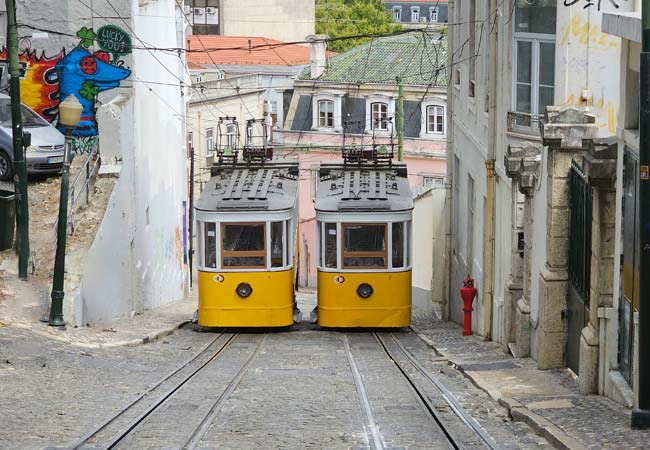
The two carriages of the Elevador da Glória, midway along the route at the passing point
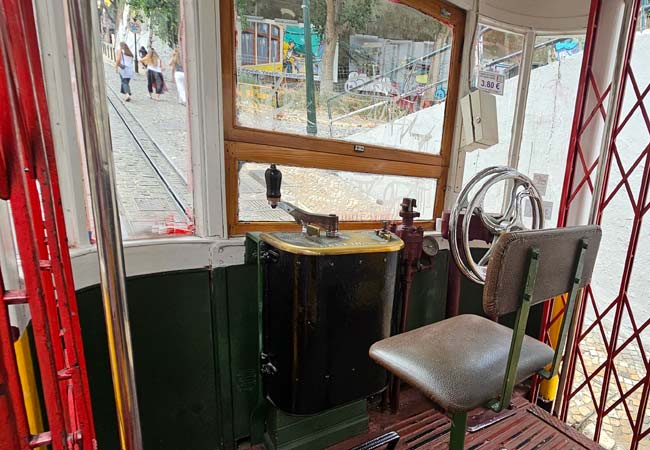
The traditional dials and levers of the driver's position
What is a funicular?
Funiculars are a highly-efficient mode of transport for taking passengers up and down steep hills.
The basic principle of a funicular is that two carriages are attached to each other by a cable, which runs through a pulley at the top of the hill. The two carriages counterbalance each other, minimising the energy needed to lift the carriage heading uphill.
Normally, the motor used to pull the carriages is located at the top of the hill, but Lisbon's funiculars are unique, as the electric motors are located beneath the carriages and are powered by the overhead cables.
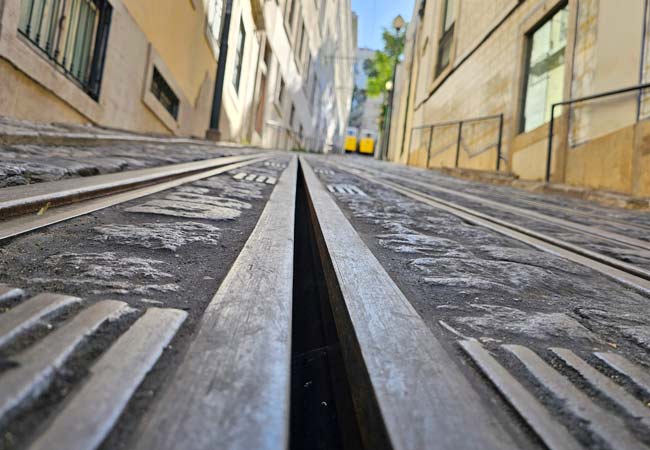
The cable used to pull the carriages is hidden below the street, and from a distance it looks like a third rail
Tourist details of the Elevador da Glória
The Elevador da Glória connects the Praça dos Restauradores (at 17 metres altitude) with the Rua de São Pedro de Alcântara on the edge of the Bairro Alto district, 44 meters higher. This is a very steep hill with an average gradient of 17 per cent - and it will feel much steeper if you try to walk it in the heat of summer!
A return ride costs €4.20, but there are much more affordable options than buying a ticket from the driver upon boarding. This onboard ticket can only be purchased with cash; card payments are not accepted.
The route of the Ascensor da Glória is only 265 meters long, which takes around 3 minutes to travel. As a tourist experience, this can feel a little disappointing, especially if you have had to wait for a couple of departures (which are every 12 minutes) and paid full price. The uphill walk is tough, but achievable for most fit people, and is often the better option if there are lots of people queueing at the bottom.
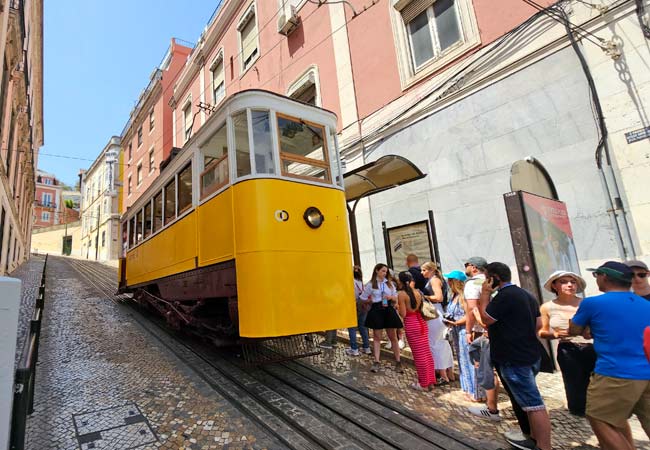
There is always a queue of passengers at the downhill funicular stop
During your sightseeing tour of central Lisbon, you will want to go to the top of the Ascensor da Glória. At the top of the hill is one of the best viewpoints of Lisbon, the Jardim de São Pedro de Alcântara. This pretty garden provides wonderful views over the Baixa district and afterwards leads your sightseeing trip into either the Bairro Alto or Príncipe Real districts.
The best time to ride the Ascensor da Glória is early in the day (before 10am) or after 4pm, when the groups of sightseers are finished for the day. The first service of the day is at 7.15am (Monday to Friday), 8.45am on Saturdays, and 9.15am on Sundays. The funicular continues late into the night, with the last service at 11.55pm.
The Elevador da Glória is part of the public transport network of Lisbon and is operated by Carris, being designated as the '51E' route.
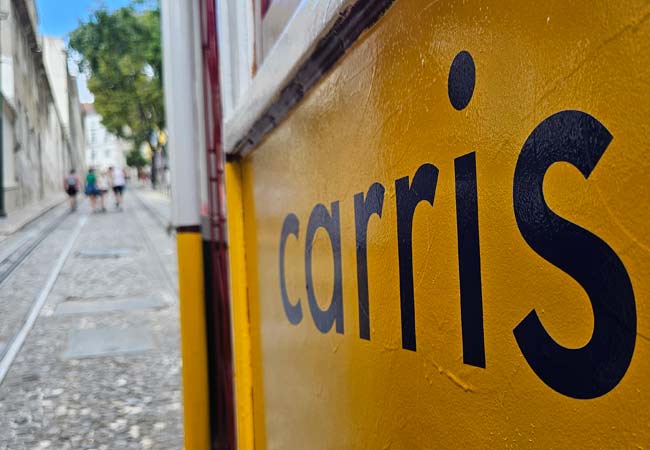
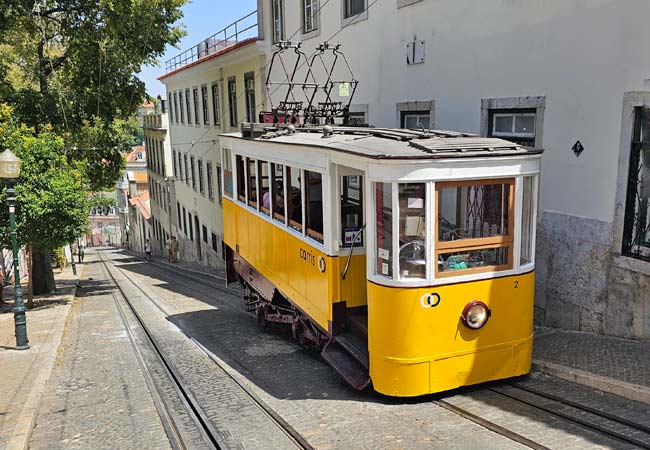
Glória at the upper stop
Better ways to pay for the Ascensor da Glória
The cash fare for the Elevador da Glória is expensive, and is purely designed to extract a little bit more money from unsuspecting tourists. There are much better options, depending on how much you will use public transport during your day of sightseeing.
If you plan to use a lot of public transport during your day, there is a 24-hour ticket that costs €7.00, which includes all funiculars, trams, the metro and buses. This is exceptional value if you also plan to ride the number 28 tram (€3 single), the Elevador da Bica (€4.20), and the Elevador de Santa Justa (€5.30!) within the 24-hour period.
The other option, if you intend to use less public transport, is to use a zapping ticket. This process involves loading credit onto a Navegante card (€0.50 for the initial purchase) and provides reduced fares, such as €1.70 for the Ascensor da Glória.
Annoyingly, both the 24-hour ticket and the zapping ticket can only be purchased from a ticket machine in a metro station. Fortunately, the Restauradores metro station is at the base of the Elevador da Glória and the entrance is on the opposite side of the road.
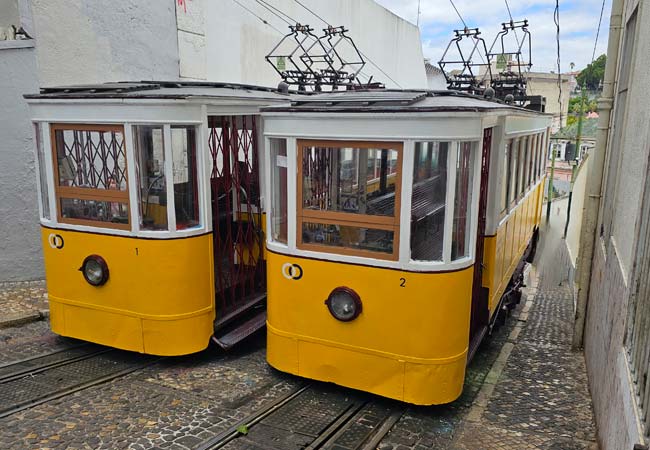
The two carriages are connected to the same cable, so that as one descends, the other is lifted and they pass each other mid-way on the route.
An alternative to the Ascensor da Glória
The Ascensor da Glória can get very crowded during peak season, but there is a much quieter alternative funicular close by. The Ascensor do Lavra is the least famous of Lisbon’s three funiculars (Bica, Glória, and Lavra) and is seldom ridden by tourists, making it the ideal choice if you want a peaceful ride or a photo standing next to one.
The Ascensor do Lavra is only 200 meters to the east of the Ascensor da Glória, on Rua das Portas de Santo Antão (GPS: 38.7178, -9.1418). The top of the Lavra funicular leads to the elegant Pena neighbourhood, which contains the pretty Campo dos Mártires da Pátria, a peaceful park, along with the Jardim do Torel viewpoint.
If you wish to visit an area of Lisbon that is completely undiscovered by tourism while you are sightseeing, Pena is the neighbourhood to head to.
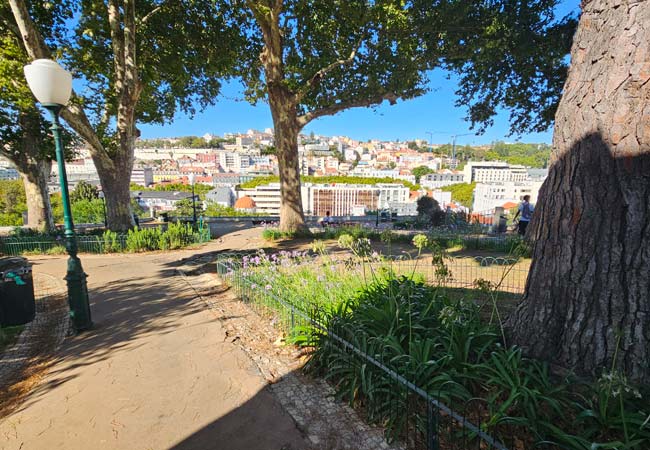
The Jardim do Torel and viewpoint at the top of the Ascensor do Lavra
History of the Elevador da Glória
The Elevador da Glória was opened on October 24, 1885, and was designed by Portuguese engineer Raoul Mesnier du Ponsard. It was the second funicular to open in Lisbon - the oldest being the Elevador do Lavra in 1884.
The original system used a rack and cable balanced by a large water counterweight within the cars, but it switched to steam power in 1886 and was electrified in 1915.
The original 1880s water-powered tram worked by filling and emptying reservoirs on the roof of the carriages, with gravity then causing them to travel along the tracks. When the upper carriage wanted to descend, it would add more water to its reservoir, with this increased weight pulling it to the bottom and hauling the other carriage uphill. This original water design influenced how the funiculars worked when they came to be steam powered and electrified, as the power was added to the carriages - which is unusual for most funiculars.
Until the end of the 19th century, the carriages were illuminated by candles during night-time journeys. The funicular was classified as a National Monument in February 2002.
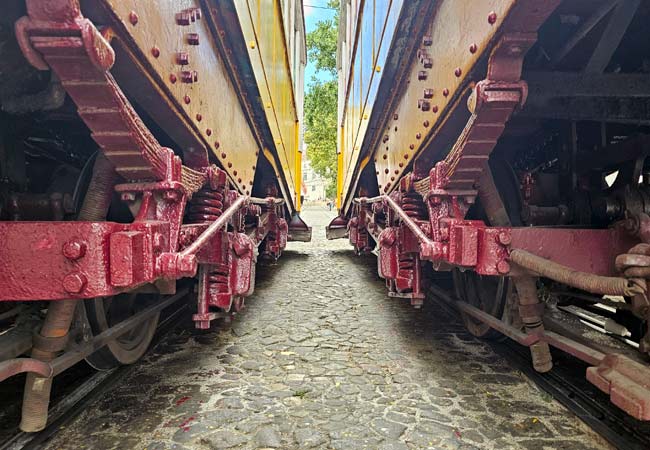
The carriages are inclined to match the gradient of the hill
The Galeria de Arte Urbana (GAU)
The Elevador da Glória passes eight boards used by the Galeria de Arte Urbana (GAU), an initiative to give street and graffiti artists a legal setting to display their works.
The art is constantly changing and is sometimes provocative, but it demonstrates Lisbon's openness to urban creativity. The original idea was to reduce the amount of graffiti on the Elevador da Glória, but it hasn't really helped.
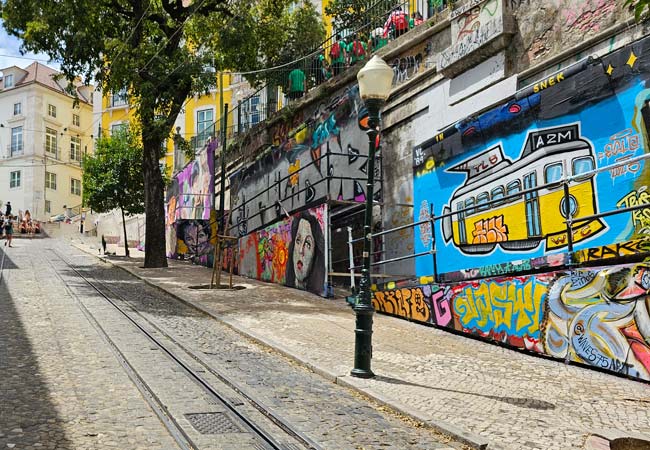
Sights near the Elevador da Glória
Jardim de São Pedro de Alcântara
The Jardim de São Pedro de Alcântara is a charming, terraced garden that offers stunning views over central Lisbon.
The lively upper terrace hosts street performers, artists and craft stalls. Amongst the buzz of activity is an ornate fountain, a series of statues and a traditional kiosk serving drinks and snacks. The lower terrace consists of a peaceful rose garden, and is a great location to escape the bustle of Lisbon.
São Pedro de Alcântara is particularly enchanting at sunset, when the orange glows of the sun illuminate the castle and Alfama districts.
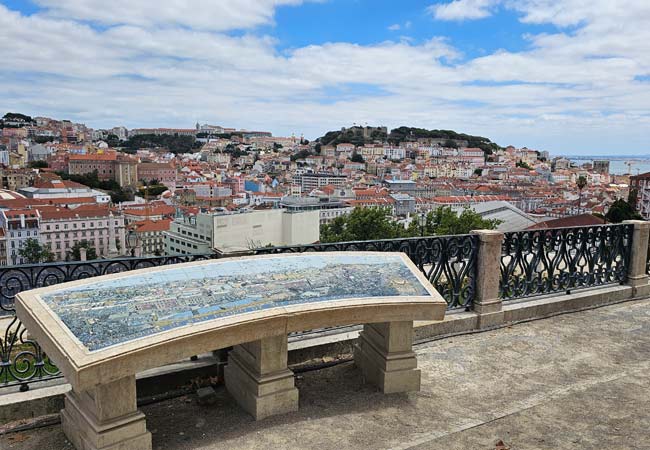
The view over central Lisbon and the castle from the upper terrace of the Jardim de São Pedro de Alcântara
Igreja de São Roque
The Igreja de São Roque is one of the earliest Jesuit churches in Portugal and a stunning example of Baroque architecture. Construction began in the 16th century, and remarkably it was one of the few buildings in Lisbon to survive the devastating 1755 earthquake. Its bland exterior conceals a richly-decorated interior, adorned with intricate gold leaf, beautiful tiles and impressive paintings.
The Chapel of St John the Baptist is an extraordinary example of 18th-century art and craftsmanship. Commissioned by King John V of Portugal, the chapel was initially constructed in Rome, blessed by the Pope, then dismantled and shipped to Lisbon, where it was reassembled inside the church.

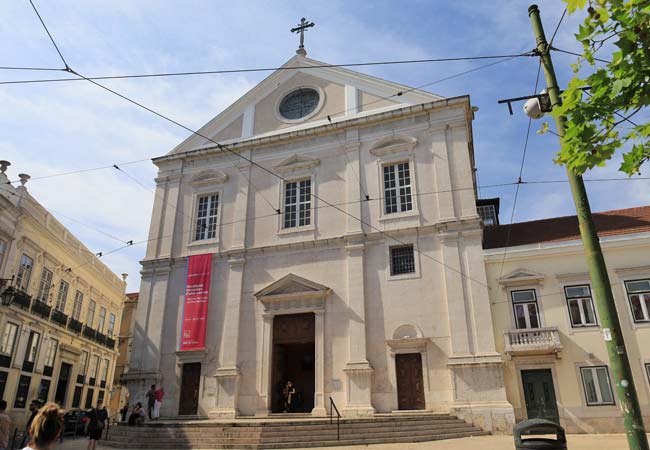
Príncipe Real district
Príncipe Real is a charming and trendy neighbourhood in Lisbon, known for its elegant 19th-century architecture, vibrant cultural scene, and lush gardens like the Jardim do Príncipe Real.
This area is a favourite among locals and tourists alike for its unique blend of traditional and contemporary elements, offering a variety of fashionable boutiques, art galleries, antique shops, and a bustling culinary scene with numerous cafes and restaurants. Príncipe Real is often associated with creativity, bohemian flair and LGBT+ friendly venues, reflecting the inclusive and diverse nature of the community. The neighbourhood's tree-lined streets and relaxed atmosphere make it an inviting place to wander and explore, providing a delightful glimpse into Lisbon's multifaceted urban life.
Related articles: The Príncipe Real district
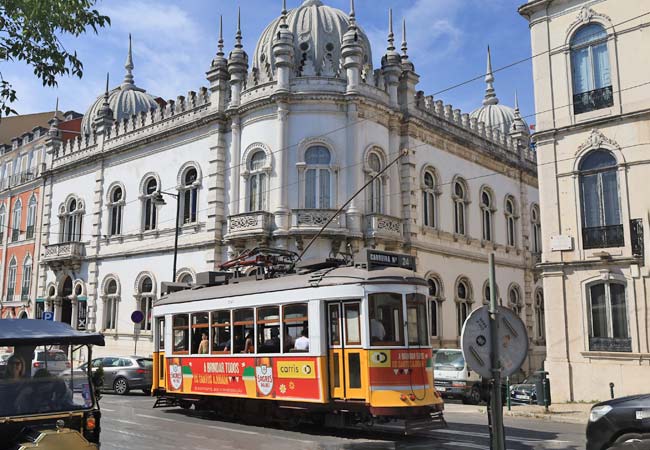
The number 24 tram passing the EmbaiXada shopping centre in Príncipe Real
The Palácio Foz
Located at the base of the Elevador da Glória, the Palácio Foz is an exquisite 18th-century palace admired for its grandeur and beautiful architectural details. Reflecting a blend of Baroque and Rococo styles, the building's ornate façade is only a prelude to its lavish interiors, which are adorned with intricate frescoes, gilded carvings and stunning chandeliers. Once the residence of the aristocracy, the Palácio Foz is now a venue dedicated to culture and the arts, regularly hosting concerts, exhibitions and various cultural events.
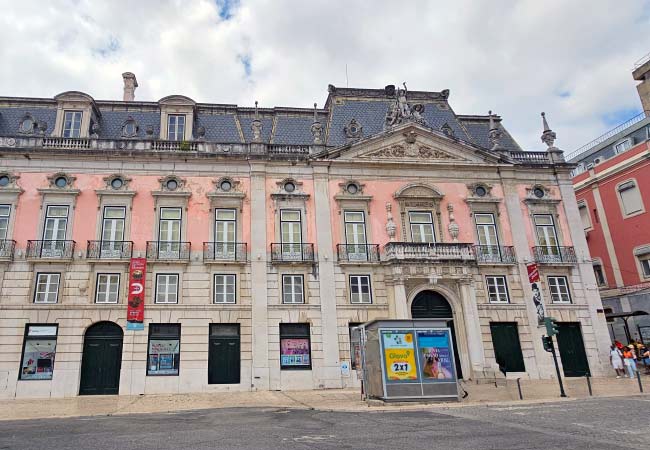
The distinctive pink exterior of the Palácio Foz
Discover more of Lisbon with our most popular guides
If you've found our content valuable, we'd welcome your support.
The digital publishing landscape has evolved significantly. As a small independent publisher, we face growing challenges. Search engines increasingly favour paid content over organic results, while AI-generated content often reproduces original work without attribution.
To support our work, please consider bookmarking this page (press Ctrl + D) for quick access. If you find an article helpful, we'd be grateful if you'd share it with friends on social media.
For specific questions, please see our Reddit community at r/LisbonPortugalTravel.
Should you notice any outdated or incorrect information, please contact us at [email protected]
Thank you for helping us continue to provide valuable content in an increasingly challenging digital environment.
A complete list of all of our Lisbon articles
If you've found our content valuable, we'd welcome your support.
The digital publishing landscape has evolved significantly. As a small independent publisher, we face growing challenges. Search engines increasingly favour paid content over organic results, while AI-generated content often reproduces original work without attribution.
To support our work, please consider bookmarking this page (press Ctrl + D) for quick access. If you find an article helpful, we'd be grateful if you'd share it with friends on social media.
For specific questions, please see our Reddit community at r/LisbonPortugalTravel.
Should you notice any outdated or incorrect information, please contact us at [email protected]
Thank you for helping us continue to provide valuable content in an increasingly challenging digital environment.



































